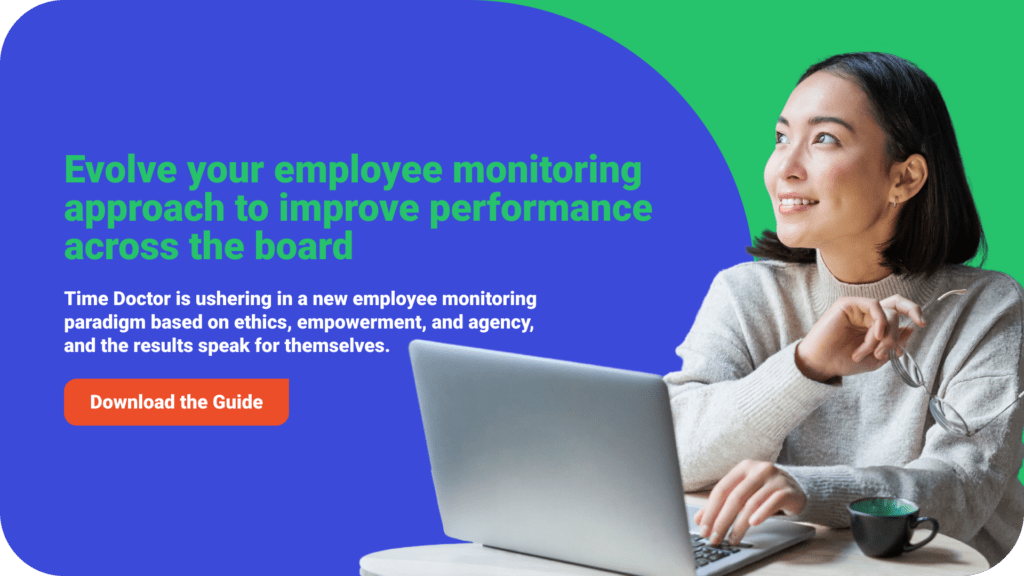As we slide into the fourth industrial revolution and the lines between physical and digital experiences fuzz, distributed work isn’t going away. Managers and employees need to trust each other, or we risk backsliding into the bad old days of panopticon monitoring.
Ethical monitoring practices create an atmosphere of trust and psychological safety among team members. Employees who feel their privacy is respected are more likely to speak up, share ideas, and collaborate effectively.
Gallup’s data shows that companies with highly engaged employees enjoy up to 43% less turnover, 64% fewer accidents and 28% less employee theft, among many other benefits.
Productivity analytics – a core tenet of effective employee monitoring – can create a workplace where employees are empowered, autonomous, engaged and motivated to contribute their best efforts. Or it can create a digital panopticon that demotivates employees and drives an immovable wedge between employees, managers and departments.
It comes down to how data is managed.

How to use productivity analytics for continuous, collaborative improvement
Democratize data
Ethical monitoring involves employees in the process. First in deciding what data will be tracked, and later by enabling employees to view and manage their own data. This sense of ownership makes employees more accountable for their own success and prevents feelings of frustration or micromanagement.
Communicate openly and often
Ethical monitoring practices prioritize transparency and open communication. When team members know how they are monitored and how data is used, misunderstandings are reduced and collaboration becomes smoother.
Connect productivity data to organizational goals
Instead of monitoring for its own sake, data should be deliberately selected for its relevance to organizational performance. Make that link clear. Employees should know how unscheduled breaks correlate to customer satisfaction (for example) so they can make informed decisions about how to use their time effectively.
Development, not discipline
Improvement-focused monitoring prioritizes employee development over punitive measures. Managers aren’t immune here; only half of US employees (51%) know what’s expected of them at work. Productivity data can identify development opportunities on both sides of the relationship, facilitating conversations that lead to productive actions.
Make informed decisions
We pointed to Microsoft’s survey, where 85% of managers felt remote teams weren’t productive. But here’s the thing: 87% of workers thought they were more effective at home, and the data took the worker’s side. Ethical monitoring means using data to overcome ingrained stigmas and collaborate more effectively in an environment of trust.
Respect individuality
Before penalizing employees for so-called unproductive time, it’s worth considering whether there could be a personal reason for the data variation. Some employees might work out problems on paper; others might be mentoring colleagues or holding sensitive conversations with clients when the monitoring software checks their productivity.
Traditional monitoring rarely allows for individuality. Time Doctor does, letting users view and edit their productivity data, including editing breaks and deleting screenshots. Managers see the data has changed. From there, they can make informed decisions based on an improvement-inspired approach,
Employees understand that flexibility comes at a cost
Trust remains one of the biggest barriers to remote working. Only around 1 in 3 managers believe people can be productive when not in an environment that enables constant supervision.
If we’ve learned anything from the last few years, it’s that this assumption has little to no basis.
- 62% of employees feel more productive working from home, and only 11% feel less productive
- People say their productivity increases by 9% at home (up from 5% during the pandemic)
Our own analysis of Time Doctor users backs up these studies. Several clients saw productivity after transitioning to remote work, while unproductive time (like browsing social media) nosedived.
However, it seems that more managers are willing to take a leap of faith – with conditions. In return for one day a week of working from home, New York City Metropolitan Transportation Authority staff recently agreed to full-time activity monitoring. One survey of 2,300 US staff from Owl Labs and Global Workplace Analytics also found that 52% of workers would take a 5% pay cut for more flexibility, and 23% would take a 10% cut.
Employees and organizations must work together to find a solution that suits everyone. Ethical employee monitoring is defined by collaborative resolutions, not conditions of employment.
There will always be some bad eggs who flaunt or break the rules. An improvement-focused employee monitoring approach does not entirely prevent disciplinary action but demotes it to a last resort.
Conclusion
The role of productivity analytics in shaping the future of work cannot be overstated. As we navigate the complexities of the digital era, the balance between monitoring and maintaining employee trust is crucial.
Productivity analytics, when used ethically, not only enhances operational efficiency but also fosters a culture of transparency, autonomy, and collaboration. By involving employees in the monitoring process, prioritizing open communication, and linking data to organizational goals, companies can leverage these analytics as a tool for continuous improvement rather than mere surveillance.
The integration of these practices is key to building a resilient, engaged workforce that is prepared to thrive in an ever-evolving work environment. Ultimately, the successful implementation of productivity analytics lies in its ability to respect individuality and reinforce mutual trust between employees and management, paving the way for a more productive, satisfied, and connected workforce.

Carlo Borja is the Content Marketing Manager of Time Doctor, a workforce analytics software for distributed teams. He is a remote work advocate, a father and a coffee junkie.


